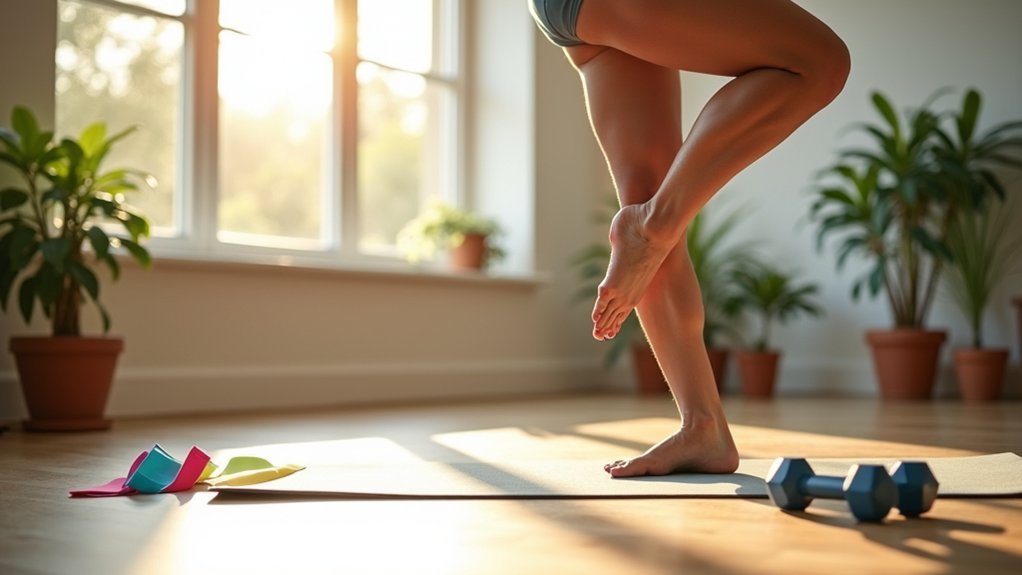For stronger bones, aim to rebound 3-5 times weekly for 20-30 minutes per session. Allow at least one rest day between workouts to support bone adaptation. Morning sessions boost energy, while afternoon workouts may optimize strength gains. Beginners should start with 2-3 shorter sessions, gradually increasing duration and intensity. Complement rebounding with resistance training 2-3 times weekly for extensive bone health. The following guidelines will help you create an effective bone-strengthening routine.
Optimal Rebounding Sessions Per Week for Bone Growth

Three to five rebounding sessions per week provides the foundation for ideal bone growth. Each session should last at least 30 minutes, though you can split this into smaller 10-minute bursts throughout your day if time is limited.
For optimal bone density, commit to 3-5 weekly rebounding sessions of 30 minutes each, or three 10-minute intervals daily.
For maximum bone density benefits, incorporate rebounding as part of a thorough exercise routine that includes muscle-strengthening activities 2-3 days weekly. This weight-bearing exercise stimulates bone formation by forcing your skeleton to resist gravity.
Start with low-intensity bouncing and gradually increase both duration and intensity as your fitness improves.
Remember to listen to your body—while consistency is essential for bone health, proper progression prevents injury. The impact forces from rebounding create the perfect stimulus for strengthening your skeletal system when performed regularly.
Time Intervals Between Rebounding Workouts for Maximum Benefits
To maximize bone-strengthening benefits, you’ll need proper recovery intervals between rebounding sessions. Allow at least one full day of rest between workouts, as this recovery period is vital for muscle repair and bone adaptation to the weight-bearing impact.
Following activity guidelines of 2-3 rebounding workouts weekly provides the ideal balance between stimulation and recovery. Your muscles and bones need this downtime to respond positively to the exercise stress.
During rest between sessions, your body rebuilds stronger—especially when supported by adequate calcium and vitamin D intake.
Don’t mistake consistency for overtraining. Rather than daily sessions, space your workouts appropriately, focusing on quality over quantity.
This strategic scheduling guarantees your bones receive enough stimulation while having sufficient time to strengthen in response to your rebounding efforts.
Duration of Each Rebounding Session for Bone Density

The ideal duration for effective bone-building rebounding workouts ranges from 20 to 30 minutes per session.
You’ll see the greatest benefits to your bone density when you commit to this timeframe 3-5 times weekly.
Don’t worry if you can’t spare a full half-hour – breaking your rebounding into smaller intervals throughout your day still provides substantial bone strength improvements.
For best results, vary your movements during sessions.
Try bouncing in different directions to stimulate bone development from multiple angles.
Monitor your intensity level carefully, aiming for moderate-impact activity that challenges your skeletal system without overstraining it.
This balanced approach to rebounding sessions creates the perfect environment for building stronger bones while keeping your workouts manageable and sustainable for long-term bone health.
Morning vs. Evening Rebounding: Timing Your Bone Exercises
Your body’s natural rhythms can affect how your bones respond to rebounding exercises, making the timing of your workouts an important consideration.
Morning sessions might give you the advantage of jumpstarting your metabolism and establishing a consistent routine that supports long-term bone health.
Evening rebounding, however, offers the dual benefit of stress relief after a full day while still providing the weight-bearing impact your bones need to grow stronger.
Optimal Exercise Timing
When considering bone-strengthening exercises like rebounding, timing can influence both your results and consistency. Your body’s natural circadian rhythms affect exercise performance, with some research suggesting strength training in late afternoon or early evening may optimize muscle-building results.
| Timing | Benefits | Best For |
|---|---|---|
| Morning | Boosts energy levels | Routine adherence |
| Afternoon | Peak physical performance | Strength gains |
| Evening | Stress relief | Unwinding |
| Consistent | Sustainable bone health | Long-term results |
| Variable | Accommodates schedule changes | Flexibility |
Morning sessions can energize your day and establish consistency for weight-bearing exercises, while evening workouts help release accumulated daily stress. The most important factor for bone health isn’t whether you choose morning or evening—it’s maintaining consistency with your 30-minute rebounding sessions most days of the week. Your individual preferences should guide your exercise timing, as you’ll stick with what feels enjoyable.
Circadian Bone Response
While consistency matters most for bone-strengthening routines, emerging research suggests that morning rebounding sessions might actually deliver better results for bone density.
Your body’s circadian rhythms create hormonal fluctuations throughout the day that greatly impact bone metabolism. Morning workouts appear to synchronize with peak anabolic hormone levels—the building blocks your skeleton needs for renewal.
Weight-bearing exercises performed earlier in the day may effectively capitalize on these natural hormonal surges, potentially enhancing bone strength gains.
You’ll likely find it easier to maintain consistent fitness routines when exercising in the morning, as these sessions often face fewer scheduling conflicts.
Body Clock Considerations
How considerably does the time of day impact your bone-strengthening workout results? Research suggests timing can influence effectiveness, though not as much as consistency itself.
Morning exercise can jumpstart your metabolism and potentially enhance bone density due to favorable hormonal conditions. Weight-bearing exercises performed early may capitalize on your body’s natural rhythms for bone development.
Conversely, evening workouts often yield superior muscle performance as your body temperature rises throughout the day. Many find they can push harder during later sessions, potentially creating greater stimulus for bone strength.
Your personal preference matters most. Whether you’re a morning person or night owl, your body clock plays a role in exercise adherence.
Choose a time that fits your lifestyle—the best bone-building routine is ultimately the one you’ll maintain consistently.
Progressive Rebounding Schedules for Different Fitness Levels
Finding the right rebounding schedule for your fitness level can dramatically impact your bone-strengthening results. Your approach should evolve as your fitness improves, ensuring consistent progress in bone density and strength.
Your rebounding routine isn’t static—it must evolve with your improving fitness to continuously build stronger, denser bones.
- Beginners: Start with 2-3 weekly sessions, gradually building to 20-30 minutes per session.
- Intermediate: Progress to 3-4 weekly sessions, incorporating varied movements to enhance bone strength.
- Advanced: Aim for 4-5 weekly sessions with high-impact exercises for maximum bone density benefits.
- Content Mix: Include both aerobic movements and muscle-strengthening exercises in each session.
- Progressive Approach: Gradually increase intensity and complexity of your rebounding routines for ideal results.
Measuring Bone Density Improvements From Regular Rebounding

Three distinct methods can help you track the bone-strengthening benefits of your rebounding routine.
First, DEXA scans provide the most accurate measurement of bone density improvements, typically recommended every 1-2 years for those at risk of osteoporosis.
Second, tracking physical performance metrics like balance time and muscle strength can indicate improved bone health, as these factors directly correlate with reduced fracture risk.
Finally, monitoring your exercise consistency—aim for 30 minutes of rebounding most days—alongside calcium and vitamin D intake can predict positive outcomes.
Remember that bone remodeling takes time.
You’ll likely notice balance and muscle strength improvements within weeks, while measurable bone density changes may take 6-12 months of consistent rebounding.
The variable gravitational forces during rebounding specifically target bone-building cells more effectively than static exercises.
Balancing Rebounding With Other Bone-Strengthening Activities
While rebounding for 30 minutes most days provides excellent bone stimulation, you’ll need to complement it with other activities for thorough skeletal strength.
You should incorporate resistance training two to three times weekly alongside your mini-trampoline sessions to target different bone areas through varied directional forces.
Allow at least one day between high-impact rebounding workouts for ideal recovery, using these rest periods for gentler bone-supporting activities like walking or yoga.
Optimal Rebounding Duration
To maximize bone health benefits, rebounding should ideally be practiced for 20-30 minutes, 2-3 times weekly. This weight-bearing exercise complements your bone-strengthening routine when balanced with other activities.
- Incorporate short bursts of varying intensity to enhance bone health while maintaining cardiovascular fitness.
- Alternate rebounding days with muscle-strengthening exercises for best bone support.
- Complement your routine with other weight-bearing activities like walking or dancing.
- Aim for consistency rather than lengthy sessions – quality trumps quantity.
- Consult your healthcare provider before starting, especially if you have osteoporosis.
Remember that effective rebounding doesn’t require long sessions – the key is regular practice with proper form and appropriate intensity for your fitness level.
Cross-Training For Bones
Creating a thorough bone-strengthening routine requires more than just rebounding alone. To maximize bone health, you’ll need a cross-training approach that combines various weight-bearing and muscle-strengthening exercises.
| Exercise Type | Bone Health Benefits |
|---|---|
| Rebounding | Low-impact stress, improves balance |
| Walking | Weight-bearing, accessible daily activity |
| Dancing | Dynamic movement, varied impact levels |
| Resistance | Builds supporting muscles around bones |
| Balance | Reduces risk of fractures from falls |
Aim for at least 30 minutes of weight-bearing activity most days, plus muscle-strengthening exercises 2-3 times weekly. If you have osteoporosis, safely combine moderate-impact activities like rebounding with low-impact options. This diverse approach not only strengthens bones but also improves overall fitness, coordination, and greatly decreases your risk of fractures.
Recovery Between Sessions
Just as your bones need stress to grow stronger, they also require adequate recovery time between workouts to rebuild and regenerate. Your bone health depends on finding the right balance between exercise and rest. Allow at least one full day between sessions targeting the same muscle group to maximize benefits.
- Alternate moderate-impact exercises (walking, dancing) with muscle-strengthening activities for balanced bone health.
- Include 2-3 days of muscle-strengthening workouts weekly with varied movements.
- Try low-impact activities like swimming on recovery days to maintain fitness.
- Incorporate flexibility exercises such as yoga twice weekly to support overall health.
- Balance training reduces fall risk while giving bones time to strengthen.
This strategic approach to recovery guarantees you’re not just working hard but working smart—giving your skeletal system the best conditions for long-term strength and resilience.
Recovery Periods: When to Rest Between Rebounding Workouts
While rebounding offers tremendous benefits for your bone health, allowing proper recovery time between sessions is equally important. Experts recommend at least 48 hours between rebounding workouts to give your muscles and bones adequate time to repair and strengthen.
Incorporating regular rest days prevents overuse injuries and fatigue that could compromise your bone health progress. Listen to your body—if you’re experiencing soreness or unusual fatigue, it’s wise to take additional recovery time.
On your rest days, consider engaging in low-impact exercises or active recovery activities like walking or gentle stretching. These maintain circulation without stressing your bones.
Rest doesn’t mean inactivity—gentle movement keeps circulation flowing while giving your bones the break they need.
For ideal results, aim for rebounding workouts 2-3 times weekly, ensuring you’re balancing activity with the recovery periods your body needs to build stronger bones.
Age-Specific Rebounding Frequencies for Bone Health
Rebounding needs vary considerably across different age groups, with each life stage requiring tailored exercise frequencies for ideal bone development and maintenance.
Your bone health depends on getting the right amount of weight-bearing exercises at your current age.
- If you’re 18-29, combine high-impact rebounding with strength training 3-4 times weekly.
- For adults 30-50, incorporate muscle-strengthening activities 2-3 days per week to stimulate bone renewal.
- Over 50? Engage in weight-bearing exercises like rebounding for at least 30 minutes most days.
- Older adults with bone concerns should focus on moderate-impact rebounding and balance training 2-3 times weekly to reduce fracture risk.
- Children need daily weight-bearing exercises—aim for 60 minutes to maximize bone development during vital growth years.
Seasonal Adjustments to Your Rebounding Routine
How often do you adjust your exercise routine when seasons change? Your rebounding routine deserves seasonal modifications to maintain bone-strengthening benefits year-round.
During colder months, shift to more indoor sessions to guarantee consistency in your training. Winter workouts can feature lighter, low-impact movements that accommodate naturally lower energy levels while still supporting bone health.
As temperatures warm, gradually increase both intensity and duration of your rebounding exercise. Spring and summer provide ideal conditions for more vigorous routines that maximize bone-strengthening benefits.
Keep motivation high by incorporating seasonal music into your sessions.
Don’t forget practical considerations – invest in a quality indoor rebounder for winter use and breathable clothing for summer workouts. These seasonal adjustments will help maintain your commitment to bone health regardless of weather challenges.
Frequently Asked Questions
How Often Should You Do Bone Strengthening Exercises?
You should do weight-bearing exercises for 30 minutes most days, muscle-strengthening exercises 2-3 days weekly, and balance exercises twice weekly. Aim for 150 minutes of moderate activity weekly for ideal bone health.
How Long Does It Take for Exercise to Improve Bone Density?
You’ll typically see improvements in bone density within 6-12 months of consistent exercise. If you’re strength training twice weekly and doing 30 minutes of weight-bearing activities most days, you’ll notice faster results.
Is Walking 2 Miles a Day Good for Osteoporosis?
Yes, walking 2 miles daily is beneficial for osteoporosis. You’re engaging in weight-bearing exercise that strengthens bones, improves balance, and helps meet recommended physical activity guidelines. It’s an excellent low-impact option for bone health.
What Is the Best Exercise to Increase Bone Density?
Weight-bearing exercises like walking, jogging, and resistance training are best for increasing bone density. You’ll want to combine these with high-impact activities that you can tolerate to maximize bone strengthening benefits.
In Summary
You’ll see the best bone-strengthening results with 3-4 rebounding sessions weekly, each lasting 10-20 minutes. Don’t exercise on consecutive days—your bones need 24-48 hours to respond to the stimulus. Adjust your routine based on your age and fitness level, and complement rebounding with other weight-bearing activities. Remember, consistency trumps intensity when building bone density. Listen to your body and gradually increase duration as you progress.




Leave a Reply